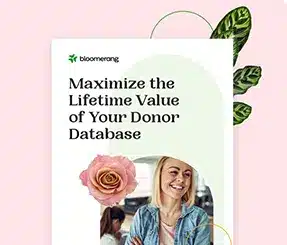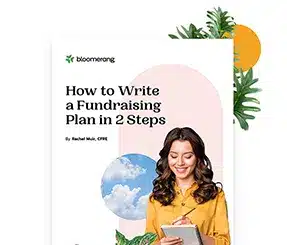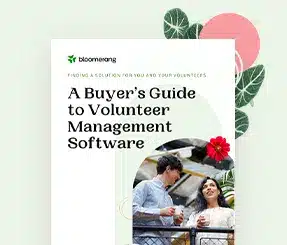Special Event Follow-Up To Convert Guests To Loyal Donors


Full Platform Overview Chat With Us



Full Platform Overview Chat With Us




SPECIAL EVENTS WORTH DOING MUST NOT EXIST IN A VACUUM.
If you’re planning a special event, write this down on a sticky note, post it next to your computer, and make it your mantra.
Or reap the consequences of doing fundraising the absolutely least cost-effective way possible.
What a waste.
You see, stand-alone special events are mere one-time transactions. And they’re expensive. Unless you understand why you’re really running them, and what you hope to gain over the longer term, you won’t get out of them what you put in.
Fundraising cost/benefit expert James Greenfield has worked with the Association of Fundraising Professionals over more than two decades to calculate costs of different fundraising strategies. The only thing more expensive than events is direct mail (and most folks know they’re in that for the long-term donor value).
Ask yourself: “Why are we running this event, and what will success look like, today and tomorrow?”
Today, your event will cost you dearly. In my experience, events don’t even really yield 50 cents on the dollar. Because most folks neglect to include the real costs, like staff salaries, other administrative overhead and lost opportunity costs, like all the time your CEO and board members spend on the event instead of major donor fundraising.
Unless you’re careful, just like what you suck into a vacuum, events in isolation will suck up all your resources; then leave them as waste to be thrown out in the garbage. They’ll have no further use.
There’s a way to avoid the one-and-done syndrome and escape post-event letdown.
In fact, there’s a way to turn your event into a super-de-duper booster rocket for subsequent fundraising efforts!
It’s called planned and smartly-executed follow-up.
It’s what you do to build a relationship with your guests, and encourage them to become further involved and invested. And just as we discussed “not missing a trick” with your details during the event (see Part 2), you don’t want to miss a trick after your event either.
Planning ahead for meaningful follow-up requires you to recognize that most events are less about actual monetary return on investment (ROI) than they are about return on engagement (ROE).
In other words, if you’re doing an event purely to raise money there are other more cost-effective fundraising strategies. However, events done right are an excellent awareness-raising, branding and donor cultivation tool. You just have to go into events fully cognizant of what success will look like, both from your organization’s and your donor’s perspectives. Only armed with this understanding can you create events that will be worth your while.
Success over the long term requires both (1) attention to detail and (2) planning ahead for what happens post-event. We looked at the detail in Part 1, where we looked at how to create first and last “Wow” impressions, and in Part 2, where we looked at creating all the “Wows” in between. In today’s final installment of our series on delivering events that turn attendees into loyal, passionate donors we’ll look at the all-important event follow up that ‘seals the deal.’
A fundraising event is not an end in and of itself. Often you may never see your event attendees again (or at least not until the next event) because these folks are golfers or ‘thoners,’ not donors. At best, they are “casual” supporters. Don’t let them stay that way! Develop a strategic approach so that you convert casual event supporters into ongoing, engaged annual fund investors.
This means carefully considering what follow-up actions you want attendees to take after attending your event. For first-time guests, you may just want them to join your email list so they can begin to learn more about you. For other guests, you may want them to get further engaged through volunteer or other activities. And for others, you may want to seek an additional or upgraded donation.
If you want more, you must give more. That means gratitude and reporting back on impact and showing the donor you care about them. You may have made folks feel good at the event, but that was a one-time high. Folks don’t often stay loyal based on a one-time experience. Even those who fall in love at first sight generally have at least a few more dates before deciding to tie the knot.
There’s a reason some folks call events ‘friendraisers’ more than ‘fundraisers;’ they’re a beginning, not an end. An on-ramp to more passionate investment.
Think of every single attendee as a potential major donor and lifelong evangelist.
And think of your event as one step in a series of strategies leading up to an ask.
An event is really a giant donor cultivation tactic, where your goal is to make an emotional connection with your guests so you can fan the flames of their passion and make a larger ask at some point down the line. If you’re letting your event be a stand-alone one trick pony you’re really wasting your energy and resources.
So how do you avoid a one-night stand with your donor?
For starters, you call them in the morning! And to do this, you need to have their name and contact information. It’s amazing to me how many organizations allow businesses to fill up tables with their employees, and don’t bother to even capture this basic information about who was in attendance. Without this, you can’t reach out and build stronger relationships with these folks – no matter how inspired they may have been by your program. It is absolutely insufficient to merely send a thank you letter to the director of corporate relations. Every single person at the table needs a thank you!
This holds true for guests of your board members and donors as well. Ask for their names and addresses. Just because someone comes as a guest, or a walk-a-thon participant or pledger, does not mean they know much about you. If they give to you once, and really don’t know you, then what on earth makes you think they’re going to want to give again?
They might, but only if you treat them well. Only if you show them you’d like to get to know them better. Only if you delight them, intrigue them and make them feel taken care of.
Bottom line: it’s what you do after the event that counts when it comes to donor retention.
Before the event it’s fine to focus your energy on getting folks to attend (otherwise, you’ve nothing to work with). And it’s fine to fill the event with mission moments and WOW experiences (otherwise you’re not going to inspire anyone). But if you stop here you’re not going to build sustainable relationships with your attendees.
The warm afterglow of the event fades very quickly. So prepare ahead to hit the ground running. You’ll likely have a number of different audiences; think about each one individually. For example:
These are the folks who come as unpaid guests of other donors. Often, especially when corporations buy a table, there can be quite a few of these folks. Don’t write them off. If your event does a good job of inspiring folks about your mission, there’s absolutely no reason these guests cannot become individual donors to your organization.
If you host a walk-a-thon you’ll often have scads of folks who write checks. These folks are connected to their friend at this point; not to you. But you can change that by providing them with inspiring stories about your mission. Operate under the assumption they’re already part of your community, and include them. Folks like being a part of a community if they’re warmly welcomed and embraced.
These are often first-time supporters who’ve come to learn more about you. Or maybe the event just sounded like fun. Be prepared to welcome them into your community, and not just treat them as one-time purchasers of a service.
These folks may be ‘hangers on’ who decided to participate in the fun and excitement. They’ll likely consider themselves to be donors at this point, so be sure to include them and welcome them as such.
Events can be awesome major donor cultivation opportunities if you plan ahead to follow up with folks in a manner that makes them feel even more connected to you than they did previously.
Let’s take a look at some essential steps that will facilitate meaningful follow-up.
1. Capture Contact Information
2. Assign Board or Staff to Connect with New Guests
The more personally you can connect with folks, the better. If you’ll have new guests in attendance, plan ahead to assign someone on your staff or board to connect with them at check-in or go over to their table and introduce themselves during the event. Or assign table ‘hosts’ so everyone has access to an ‘insider’ who can make them feel welcome.
Give folks who take on assignments a few ‘getting to know you’ questions, and ask them to make notes on what they learn during the course of the event. Always ask attendees if they’d like to learn more about the organization (programs, volunteer activities, advocacy opportunities, etc.) Debrief these folks so you can capture this information in your database and follow-up with whatever folks expressed an interest in.
3. Assign Board or Staff to Connect with VIP Major Donor Prospects
Take a similar approach to the one you take with new guests. Your goal is to learn more about what inspires these folks, and to begin to build bonds of friendship. If you know a donor has an interest in a particular area, consider seating them with a program person who works in that area. Or with a volunteer who volunteers in that program.
Once you’ve taken these steps, consider what you’ll you do to build stronger relationships, now that you have contact information and have learned a bit more about your attendees. Remember, you want to strike while the iron is hot! If you wait too long the donor will forget about you. So it’s imperative you plan your follow-up before you hold your event.
You’ll want to put all your strategies into a calendar. Here are some suggestions
It takes planning, persistence and patience.
It also takes a team approach. If you feel you can’t get this all done on your own, recruit other staff or board or volunteers to help. Don’t write folks off just because they don’t respond with a gift or other action right off the bat. You’ve got to do the relationship building first.
Don’t delay, and don’t stop. Cultivating event attendees takes about a year until they’re ready for an increased ask. But you’ve got to start immediately after the event or folks will forget who you were and why they attended. Send relevant, compelling information with stories about impact. Give them news they can use. Invite them to join your team in other ways than giving money. Don’t just ask for treasure; ask for time and talent as well.
Once they’re on board and a part of your community, then ask for a monetary gift. If you’ll forgive the addiction analogy, events should not be a one-time high. Events should be an intoxicating gateway drug. It’s your job to get your one-time users “hooked.” If you don’t, your investment in the event has been for naught.
Comments
Paula Manczuk
Claudia Couture